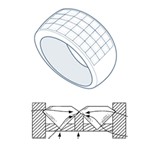Engagement
Some points to keep in mind…
- Diamond shape/cut, size and clarity (see our Diamond Information page)
- What type of gold/metal (choose from yellow, white, rose or a combination)
- Budget
- Lifestyle
Ring Settings
Bezel Setting
With a Bezel setting, a rim holds the stone and surrounds the gem. Bezels can have straight edges, scalloped edges, or can be molded into any shape to accommodate the stone. It can wrap all the way around the stone or only partially surround it, depending on the style of the ring. This type of diamond ring setting is good for protecting the stone and often makes it look larger..
Prong setting
The most common type of setting style, especially for solitaire rings, is the prong setting which holds your stone securely while still allowing a good deal of light to enter your diamond or gemstone. To increase this effect, the centre stone is sometimes raised above the shank, to give it a larger, more important appearance. The prongs are attached to the central setting of a ring, known as the head or basket. Each prong extends upward and outward from the head, gripping the diamond with an arch at the top.
Pavé setting
Similar to channel setting, a pave ring setting has a band that is covered with dozens of tiny diamonds – so much so that the metal band barely shows through. The difference is that these diamonds are often very small and held in place with small prongs or beads. The result is a band that looks almost like it’s made entirely of diamondsBar setting
Similar to a channel setting, a bar setting uses a thin bar of u- or v-shaped metal to hold diamonds or gemstones in place on two sides. When there is a series of stones set next to each other using this technique, you will see a narrow bar between each one. Similar to the Channel setting, this type of setting is also most commonly used in anniversary and wedding bands.








